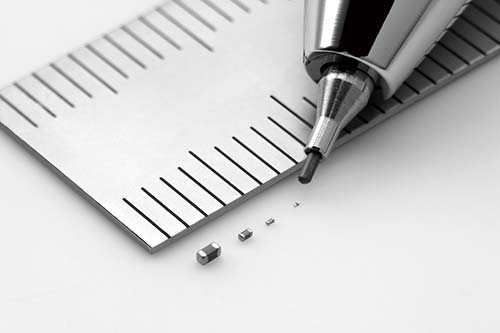 Murata has been honored with an IEEE Milestone award by the Institute of Electrical and Electronics Engineers (IEEE), the world’s largest technical professional organization committed to advancing technology for the betterment of humanity. This recognition acknowledges Murata’s significant contribution to industry with the commercialization of multilayer ceramic capacitors utilizing nickel inner electrodes (Ni-MLCC).
Murata has been honored with an IEEE Milestone award by the Institute of Electrical and Electronics Engineers (IEEE), the world’s largest technical professional organization committed to advancing technology for the betterment of humanity. This recognition acknowledges Murata’s significant contribution to industry with the commercialization of multilayer ceramic capacitors utilizing nickel inner electrodes (Ni-MLCC).
About the IEEE’s Award
Since its inception in 1983, the IEEE Milestones program has been dedicated to acknowledging significant technical accomplishments across all domains related to the IEEE. The purpose of milestones is to recognize the technological innovation and excellence demonstrated in unique products, services, seminal papers, and patents, which ultimately benefit humanity.
The proposal of milestones is open to all IEEE members and must be sponsored by an IEEE Organizational Unit (OU), such as a section, society, chapter, or student branch. Following a recommendation by the IEEE History Committee and subsequent approval by the IEEE Board of Directors, a bronze plaque is installed at a suitable location, accompanied by a dedicated ceremony.
In order to receive recognition, the accomplishment must showcase technological innovation that has positively impacted humanity. Furthermore, it is required that the innovation emerged more than 25 years ago and has had considerable significance over a vast geographical area. Throughout its history, the IEEE has dedicated a noteworthy 177 Milestones across the globe.
MLCC History
MLCCs made their debut as commercial products in 1966. During that period, valuable precious metals were utilized for the fabrication of MLCCs’ internal electrodes, consequently leading to a substantial unit cost, limiting their applications.
In order to replace precious metals with more affordable alternatives, a technical obstacle arose. It became imperative to devise a dielectric ceramic material that could be sintered under low oxygen conditions to prevent metal oxidation. In line with this, Murata implemented a low-cost nickel metal and concurrently devised a dielectric ceramic material. In 1973, Murata achieved successful development of Ni-MLCCs, effectively combining superior quality with affordability. This endeavor took approximately eight years to implement the material and establish a production process, with mass production beginning in 1982.
Ni-MLCCs serve as a vital electronic component and find application in numerous markets, such as automobiles, home appliances, industrial equipment, medical equipment, and communications equipment. Murata has persistently strived to achieve enhanced miniaturization, increased capacitance density, cost reduction, and other advancements tailored to specific applications. As a result, the company currently provides over 1 trillion Ni-MLCCs annually to global customers.
Typical MLCC Features:
- Outstanding High-Frequency Characteristics and High-Density Mounting: Our Ni-MLCCs possess exceptional frequency characteristics ideal for high-speed IC power supply circuits and high-frequency RF circuits, while also being compact, featuring high capacitance density, and enabling surface-mounting. Consequently, they actively contribute to the increased integration and improved communication speed of information terminals, notably mobile phones.
- High Withstand Voltage and Reliability: Ni-MLCCs possess the exceptional voltage resistance and reliability necessary within the power electronics industry. These components are primarily employed in a variety of power supply circuits, particularly in automotive electronics.
Murata Acknowledgement
We would like to express our gratitude to our customers, suppliers, and all our other stakeholders for their tremendous support on the occasion of being awarded an IEEE Milestone. Our focus is on promoting innovation that generates new value, enriching people’s lives through the provision of innovative products and technologies that lead the industry and progressing with the goal of consistently growing our corporate value.
For more information on IEEE’s award please visit here –https://ieee-jp.org/en/activity/jchc/milestone_jusho.html


